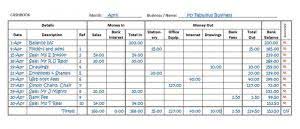Closing Entries Definition, Examples, and Recording

The eighth step in the accounting cycle is preparing closingentries, which includes journalizing and posting the entries to theledger. However, some corporations use a temporary clearing account for dividends declared (let’s use “Dividends”). They’d record declarations by debiting Dividends Payable and crediting Dividends. If this is the case, then this temporary dividends account needs to be closed at the end of the period to the capital account, Retained Earnings.
Closing Entry in Accounting: Definition and Best Practices

An accounting period is any duration of time that’s covered by financial statements. It can be bookkeeping a calendar year for one business while another business might use a fiscal quarter. After the closing journal entry, the balance on the drawings account is zero, and the capital account has been reduced by 1,300. Expense accounts have a debit balance, so you’ll have to credit their respective balances and debit income summary in order to close them.
Step 4: Close withdrawals to the capital account

When dividends are declared by corporations, they are usually recorded by debiting Dividends Payable and crediting Retained Earnings. Note that by doing this, it is already deducted from Retained Earnings (a capital account), hence will not require a closing entry. Temporary accounts include all https://www.bookstime.com/ revenue and expense accounts, and also withdrawal accounts of owner/s in the case of sole proprietorships and partnerships (dividends for corporations). The $9,000 of expenses generated through the accounting period will be shifted from the income summary to the expense account. The $10,000 of revenue generated through the accounting period will be shifted to the income summary account. In this example, the business will have made $10,000 in revenue over the accounting period.
- This involved reviewing, reconciling, and making sure that all of the details in the ledger add up.
- A net loss would decrease owner’s capital, so we would do the opposite in this journal entry by debiting the capital account and crediting Income Summary.
- The income statement summarizes your income, as does income summary.
- RetainedEarnings is the only account that appears in the closing entriesthat does not close.
- Retained earnings represent the amount your business owns after paying expenses and dividends for a specific time period.
- The first part is the date of declaration, which creates the obligation or liability to pay the dividend.
Step #1: Close Revenue Accounts

From this trial balance, as we learned in the prior section, you make your financial statements. After the financial statements are finalized and you are 100 percent sure that all the adjustments are posted and everything is in balance, you create and post the closing entries. The closing entries are the last journal entries that get posted to the ledger. The purpose of closing entries is to merge your accounts so you can determine your retained earnings. Retained earnings represent the amount your business owns after paying expenses and dividends for a specific time period. All expense accounts are then closed to the income summary account by crediting the expense accounts and debiting income summary.
- To further clarify this concept, balances are closed to assureall revenues and expenses are recorded in the proper period andthen start over the following period.
- The fourth entry closes the Dividends account to Retained Earnings.
- For example, closing an income summary involves transferring its balance to retained earnings.
- Having a zero balance in these accounts is important so a company can compare performance across periods, particularly with income.
- The third entry requires Income Summary to close to the Retained Earnings account.
Closing Entry Definition, Types & Examples
- Temporary accounts can either be closed directly to the retained earnings account or to an intermediate account called the income summary account.
- Nomatter which way you choose to close, the same final balance is inretained earnings.
- It can be a calendar year for one business while another business might use a fiscal quarter.
- The income summary account serves as a temporary account used only during the closing process.
- Temporary accounts are income statement accounts that are used to track accounting activity during an accounting period.
- A net loss would decrease retained earnings so we would do the opposite in this journal entry by debiting Retained Earnings and crediting Income Summary.
Understanding the accounting cycle and preparing trial balances is a practice valued internationally. The Philippines Center for Entrepreneurship and the government of the Philippines hold regular seminars going over this cycle with small business owners. They are also transparent with their internal trial balances in several key government offices. Check out this article talking about the seminars on the accounting cycle and this public pre-closing trial balance presented by the Philippines Department of Health.
- Printing Plus has a $4,665 credit balance in its Income Summaryaccount before closing, so it will debit Income Summary and creditRetained Earnings.
- It is a holding account for revenues and expenses before they are transferred to the retained earnings account.
- Once we have obtained the opening trial balance, the next step is to identify errors if any, make adjusting entries, and generate an adjusted trial balance.
- This trial balance gives the opening balances for the next accounting period, and contains only balance sheet accounts including the new balance on the retained earnings account as shown below.
- The total debit to income summary should match total expenses from the income statement.
How to close revenue accounts?

Such periods are referred to closing entries as interim periods and the accounts produced as interim financial statements. Interim periods are usually monthly, quarterly, or half-yearly. Another essential component of the Highradius suite is the Journal Entry Management module.

Very simply, the computer can mine all transaction data and pull out the accounts and amounts that relate to virtually any requested interval of time. Prepare the closing entries for Frasker Corp. using the adjusted trial balance provided. The fourth entry requires Dividends to close to the Retained Earnings account. Remember from your past studies that dividends are not expenses, such as salaries paid to your employees or staff. Instead, declaring and paying dividends is a method utilized by corporations to return part of the profits generated by the company to the owners of the company—in this case, its shareholders.
